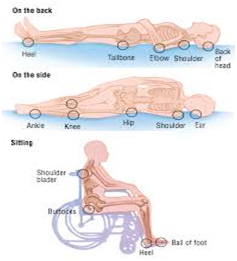
17 Jul Pressure Injuries
What is a pressure injury?
 A Pressure Injury is a localized injury to the skin and/or underlying tissue which usually occurs over a bony prominence. This generally is resulting from a period of sustained pressure on that area.
A Pressure Injury is a localized injury to the skin and/or underlying tissue which usually occurs over a bony prominence. This generally is resulting from a period of sustained pressure on that area.
The following diagram demonstrates the areas of the body where people are most likely to develop a pressure injury.Anyone sitting in the one position for up to two hours or more with limited movement is at risk of developing a pressure injury.
The development of a pressure injury can have a severe impact on a person’s life. We as healthcare professionals, must educate ourselves on these impacts and in turn, it is vital that we offer support toour staff, the clients and their families, on pressure injury prevention.
Who is most at risk?
There are several risk factors associated with pressure injuries which include those who are:
- Bedbound
- Incontinent
- Underweight or Overweight
- Immobile
- Paralyzed
- Elderly
Pressure Injuries are often cone shaped, meaning it can be difficult to determine the depth, so while they may appear fine, there could be a deteriorating wound growing towards the bone or tissue.
Pressure Injuries occur in different stages:
As healthcare professionals we grade pressure injuries into 4 categories. Stage 1 being the early stage. It is important for us to classify pressure injuries into stages as it allows us to develop a treatment plan and easily identify when they are improving.
Stage 1 is identifiable through red areas on the skin over a boney prominence. The affected area maybe painful, red and warm to touch. Skin will not be broken in this stage.
Stage 2 is identifiable through a blister like appearance or present as a shallow ulcer. The skin may be intact or slightly broken at this stage.
Stage 3 presents as full thickness skin loss. This is where you will see an open wound where some there will be oozing.
Stage 4 where there is full thickness tissue loss. The now open wound may expose bone, tendons or muscles. There may be oozing, pain and risk of infection.
The Impact of Pressure injuries
Common adverse events associated with pressure injuries if not managed correctly include:
- Infection, Sepsis & Cellulitis
- Reduced physical function
- Interruption to sleep and mood due to increased pain
- In some cases, death.

Move Every 2 Hours
Mobilize frequently. For client’s who are bed-bound, set up a turning & re-positioning chart for carers.
Daily Skin Inspection
Educate carers on how to identify a pressure injury, encourage reporting as soon as possible and implement a care strategy.
Keep the Skin Dry
Ensure the client has been dried thoroughly after their shower. For client’s who are incontinent; set up a toileting regime and conduct regular assessments.
Good Nutrition
Patients should be eating balanced, regular meals with meals that are high in protein, zinc and vitamin C. They should be encouraged to drink plenty of fluids.
Exercise
Mobilizing and exercise will keep the blood flowing and circulating around the body. Plenty of movement, even if on bed-rest, is good to help prevent pressure injuries. For patients who are on bed-rest you should consult with the physiotherapist for a list of approved exercises and management plan.
BMI
Those who are underweight and overweight are both at risk. Weigh clients regularly to maintain a healthy BMI of 18.5-24.9.
Incontinence:
Implement a toileting regime with the client and educate their family members. Along with this, educating the support staff and people involved in the clients care on identifying the early stages of a pressure injury is crucial. Early detection can lead to prevention.
Incontinence Associated Dermatitis (IAD) is characterized by inflammation of the skin associated with exposure to urine or stool.
Top Tips:
- Continence management plan
- Toileting regime
- Implement a structured skin care regime;
- Use of continence care wipes/ 3 in 1 wipes;
- Use of skin protectants, barrier cream;
- Pressure Ulcer Prevention Plan;
- Refer to a specialist within 3-5 days if there is no improvement
Conclusion
Most pressure injuries are avoidable, but some are not. As healthcare providers we must become knowledgeable and educate the wider community including our clients, their families and support networks.
Here at myNurse, we encourage all providers who supply in-home care to the elderly, disabled or terminally ill to seek professional advice if they have any clients with a pressure injury.
Remember, “An ounce of prevention is worth a pound of cure”
